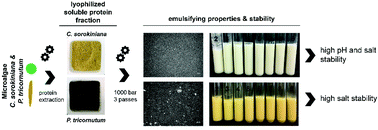当前位置:
X-MOL 学术
›
Food Funct.
›
论文详情
Our official English website, www.x-mol.net, welcomes your feedback! (Note: you will need to create a separate account there.)
Emulsifying properties of water-soluble proteins extracted from the microalgae Chlorella sorokiniana and Phaeodactylum tricornutum†
Food & Function ( IF 6.1 ) Pub Date : 2019-01-14 00:00:00 , DOI: 10.1039/c8fo02197j Sandra Ebert 1, 2, 3, 4, 5 , Lutz Grossmann 1, 2, 3, 4, 5 , Jörg Hinrichs 2, 3, 4, 5, 6 , Jochen Weiss 1, 2, 3, 4, 5
Food & Function ( IF 6.1 ) Pub Date : 2019-01-14 00:00:00 , DOI: 10.1039/c8fo02197j Sandra Ebert 1, 2, 3, 4, 5 , Lutz Grossmann 1, 2, 3, 4, 5 , Jörg Hinrichs 2, 3, 4, 5, 6 , Jochen Weiss 1, 2, 3, 4, 5
Affiliation

|
This study investigated the formation and stability of emulsions with lyophilized water-soluble protein extracts from two different microalgae species. Lyophilized soluble protein extracts from Chlorella sorokiniana and Phaeodactylum tricornutum with a protein content of 39.2 and 37.2 wt%, respectively, were used. Drop-shape analysis showed them to have considerable interfacial activity at the oil–water interface. The application in emulsions, prepared by high-pressure homogenization (1000 bar, 3 passes, 5.0 wt% oil) further revealed that a concentration of 1.0 wt% soluble protein from Chlorella sorokiniana was sufficient to manufacture an emulsion with a monomodal droplet size distribution and a small volume based mean particle diameter (d43 = 232 ± 22 nm). Emulsions remained stable throughout 7 days of storage (d43,7d = 265 ± 4 nm). In contrast, 3.7 wt% of the respective proteins from Phaeodactylum tricornutum were needed to obtain a stable emulsion (d43 = 334 ± 12 nm and d43,7d = 325 ± 8 nm). Emulsions prepared with both algae fractions showed unusually high salt stabilities up to 500 mM of sodium chloride, with no appreciable changes in volume based mean particle diameter, appearance, or microstructure. Furthermore, model emulsions with soluble lyophilized proteins from Chlorella sorokiniana had a very high stability toward changes in pH (pH ≥ 5), whereas soluble proteins of Phaeodactylum tricornutum showed only a moderate pH stability with the smallest volume based particle size at pH 7.
中文翻译:

乳化从微藻中提取的水溶性蛋白质的性质小球藻sorokiniana和三角褐指藻†
这项研究调查了来自两种不同微藻物种的冻干水溶性蛋白质提取物乳液的形成和稳定性。使用了来自小球藻和小角藻的冻干可溶性蛋白质提取物,其蛋白质含量分别为39.2和37.2重量%。液滴形状分析表明,它们在油水界面具有相当大的界面活性。通过高压均质(1000 bar,3次通过,5.0 wt%油)制备的乳液中的应用进一步表明,来自Sorokiniana的小球藻浓度为1.0 wt%的可溶性蛋白足以制备具有单峰液滴尺寸分布的乳液。基于体积的小平均粒径(d43 = 232±22 nm)。乳液在整个存储7天中保持稳定( d 43,7d = 265±4 nm)。与此相反,从相应的蛋白的3.7%(重量)三角褐指藻中需要获得稳定的乳状液( d 43 = 334±12 nm和d 43,7d = 325±8纳米)。用两种藻类馏分制备的乳液在高达500 mM的氯化钠中均显示出异常高的盐稳定性,基于体积的平均粒径,外观或微结构没有明显变化。此外,带有来自可溶性小球藻的可溶性冻干蛋白的模型乳剂对pH值( pH≥5)的变化具有很高的稳定性,而角皮鞭毛线虫仅在pH 7时表现出中等的pH稳定性和最小的基于体积的粒径。
更新日期:2019-01-14
中文翻译:

乳化从微藻中提取的水溶性蛋白质的性质小球藻sorokiniana和三角褐指藻†
这项研究调查了来自两种不同微藻物种的冻干水溶性蛋白质提取物乳液的形成和稳定性。使用了来自小球藻和小角藻的冻干可溶性蛋白质提取物,其蛋白质含量分别为39.2和37.2重量%。液滴形状分析表明,它们在油水界面具有相当大的界面活性。通过高压均质(1000 bar,3次通过,5.0 wt%油)制备的乳液中的应用进一步表明,来自Sorokiniana的小球藻浓度为1.0 wt%的可溶性蛋白足以制备具有单峰液滴尺寸分布的乳液。基于体积的小平均粒径(d43 = 232±22 nm)。乳液在整个存储7天中保持稳定( d 43,7d = 265±4 nm)。与此相反,从相应的蛋白的3.7%(重量)三角褐指藻中需要获得稳定的乳状液( d 43 = 334±12 nm和d 43,7d = 325±8纳米)。用两种藻类馏分制备的乳液在高达500 mM的氯化钠中均显示出异常高的盐稳定性,基于体积的平均粒径,外观或微结构没有明显变化。此外,带有来自可溶性小球藻的可溶性冻干蛋白的模型乳剂对pH值( pH≥5)的变化具有很高的稳定性,而角皮鞭毛线虫仅在pH 7时表现出中等的pH稳定性和最小的基于体积的粒径。


























 京公网安备 11010802027423号
京公网安备 11010802027423号